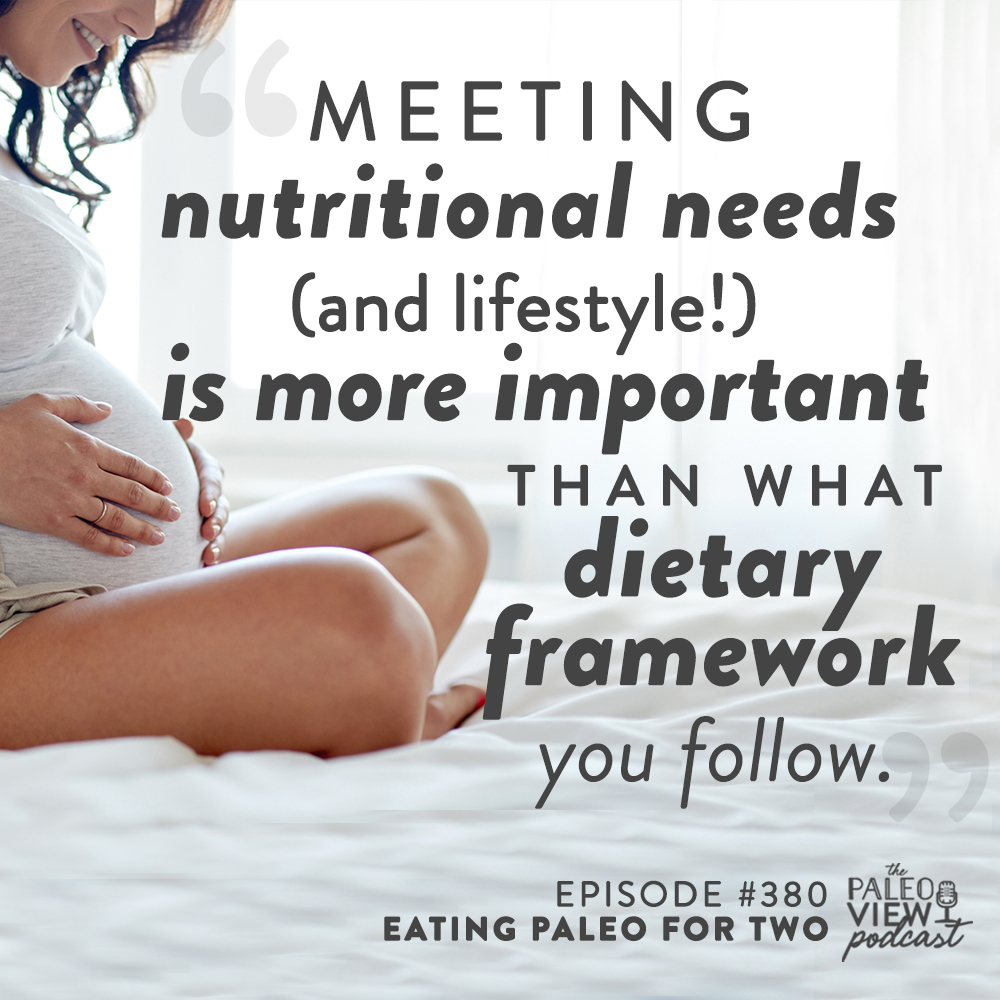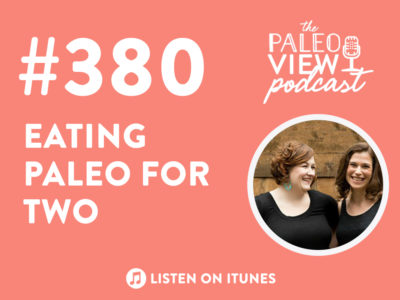On this week’s show, Stacy and Sarah address a listener’s question about food aversions and cravings during pregnancy. The hosts share on their pregnancy craving experiences, break down the science behind cravings and nutritional needs, and share feedback on how to address this chapter in life. Tune in below!
If you enjoy the show, please review it on iTunes!
The Paleo View (TPV), Episode 380: Eating Paleo for Two
Welcome back to episode 380, where we are going to try so hard to not be the longest podcast. (0:40)
For those who are listening to this in America – happy Thanksgiving!
Stacy hopes that everyone had a wonderful holiday with your family.
This was Sarah’s first Thanksgiving as an American.
Stacy saw Frozen 2 and recommends it to others; she really enjoyed it.
This week’s episode is about food cravings while you are pregnant.
Listener’s Question
Here is a question that Stacy and Sarah received that sparked the topic for this week’s show (5:11):
Since becoming pregnant, I have felt nauseous all day, every day, and the thought of food has been unappealing.
All of my regular Paleo foods, which I loved eating before, seem revolting.
Save 70% Off the AIP Lecture Series!
Learn everything you need to know about the Autoimmune Protocol to regain your health!
I am loving this AIP course and all the information I am receiving. The amount of work you have put into this is amazing and greatly, GREATLY, appreciated. Thank you so much. Taking this course gives me the knowledge I need to understand why my body is doing what it is doing and reinforces my determination to continue along this dietary path to heal it. Invaluable!
Carmen Maier

I am craving food that is sweet like juice and fruit, which is not something I ate a lot of before.
I also crave bread and fast food. I am loving the salty and greasy foods and so far have found Paleo substitutions, but I know that is not healthy either.
Do you have any suggestions on what to do?
Should I just give up the paleo lifestyle for my pregnancy and get back into it afterward?
I fear to gain back the 100lbs I lost over the past two years.
Thanks so much! I love your podcast it taught me all about paleo. I had no idea what it was before you guys!
Stacy said kudos to this listener.
Neither Stacy or Sarah were Paleo while pregnant.
For Stacy, she found Paleo through a breastfeeding perspective, but not a pregnancy perspective.
Stacy feels that there are things you can do to steer yourself to a healthier option.
Remember, there is nothing healthy about looking back and having guilt about what you did or did not do during your pregnancies.
Do not let perfection be the enemy of good.
Sarah and Stacy want to talk about how you can do the best you can while maintaining quality of life.
It doesn’t serve us well to live with absolutes and ultimatums.
Sarah brought up the way the 80/20 rule can be utilized here.
In order to maintain this for the rest of your life, the goal is to make the best choice as often as you can.
The goal is to maintain a healthy relationship with food, and yourself.
Sarah talked about the gray area foods.
When we assign intent to food it opens up the door for our food choices to be stressful.
Food is meant to nourish our bodies, and our diet template should inform us as to what eating style works best for us as an individual.
Sarah’s goal is nutrient sufficiency, and she knows which foods her body does not tolerate.
Other than avoiding foods that will make her ill, Sarah is looking at foods for their nutritional value.
Thinking of diet in terms of ‘what does my body need’ and are my food choices meeting those needs – allows for a level of flexibility.
This flexibility allows us to get away from that mindset of labeling food as good or bad and getting fanatical about the foods we are eating.
Stacy’s Pregnancy Cravings Story
When Stacy was pregnant, she very much craved fast food. (15:30)
Food from Taco Bell with beans was the thing she craved most.
While out one day, Stacy told Matt that she needed a bean burrito.
Ten minutes had passed by and she still didn’t have her burrito, so Stacy yelled at Matt that she was going to die and that he didn’t understand what was happening.
Stacy tells listeners this story to convey just how very real pregnancy cravings are.
In the case of pregnancy, something happens that takes over the normal part of who you are and become intensified.
The Science
There are some interesting hypotheses and bits of data that will help to explain the strong cravings that some pregnant women do have. (19:28)
Between 60 and 90% of women experience a strong level of cravings.
What foods women are cravings tend to be culturally influenced.
Stacy and Sarah shared a bit about how their cravings varied from pregnancy to pregnancy.
There was a study in Tanzania where they looked at what pregnant women were craving and found that a 1/4 was meat, a 1/4 was mangoes, a 1/5 of women craved yogurt, 1/5 craved oranges, 1/6 craved plantains.
Sarah thinks that we are craving some kind of flavor experience, and culturally we have associations with that flavor experience.
There are two or three plausible explanations for what is driving those cravings.
One is a change in hunger hormones.
It is not fully understood how a change in hunger hormones is causing cravings for specific foods.
There are also changes to our taste buds that are happening during pregnancy, specifically our salt sensitivity decreases.
This may explain the desire for more extreme flavors.
These are often the foods that are super rewarding to the brain.
Sarah explained the way that different areas of the brain connect to our senses.
This area of science is all very hypothetical.
Nutritional Needs
There are certain nutrients that are very important for supporting development of the fetus, so the demand for these increases while pregnant. (29:05)
When we are in a place where we are eating a relatively healthy diet, and we are better able to eat intuitively, we will naturally crave these nutrient-dense foods in pregnancy.
For people who can’t eat intuitively, they just tend to crave food.
Calcium and magnesium deficiencies can manifest as sugar cravings.
In pregnancy, we don’t understand a direct one-to-one correspondence.
Folate is needed from very early on in pregnancy to support healthy neural tube development in a fetus’s brain and spinal cord.
The recommended intake for pregnant women (as well as women planning to conceive) is 600 to 800 mcg daily, and the best sources are leafy green vegetables, asparagus, broccoli, avocados, nuts, seeds, beets, cauliflower, and squash.
Vitamin A is vital for embryonic development, including the growth of the eyes, heart, lungs, kidneys, central nervous system, respiratory system, and circulatory system.
It is best to meet your Vitamin A requirements from animal foods.
Vitamin D plays a critical role in facilitating calcium absorption, metabolism, and immune function.
Calcium is needed for skeletal development, blood pressure regulation, and proper muscle and nerve functioning, and it becomes particularly important for the fetus during third-trimester bone development.
The best Paleo-friendly sources are leafy green vegetables, broccoli, small bone-in fish like sardines, and grass-fed dairy.
There are easy tricks you can do to increase your calcium intake.
Choline is important for the development of the fetal nervous system, neural tube, and brain.
Pregnant women should consume at least 450 milligrams per day. The richest sources are egg yolks, liver, shrimp, and beef.
Iron is needed for a fetus’s rapidly developing blood supply and for the expanding blood supply of the mother.
For pregnant women, 27 milligrams daily is recommended. The best sources are red meat, organ meat, and leafy green vegetables.
Zinc is used for fetal cell growth, as well as supporting immunity, enzyme production, and insulin production in the mother.
Pregnant women should aim for 11 milligrams per day from rich sources like beef, pork, poultry, seafood (especially oysters), nuts, and seeds.
Although there aren’t clearly established omega-3 requirements for pregnant women, essential fatty acids are recommended.
The best sources being low-mercury fatty fish and other seafood, walnuts, and omega-3–enriched eggs.
When it comes to quality seafood sources, Sarah referred listeners to check out this podcast episode.
The Bigger Picture
Sarah feels that the primary criteria for diet, in general, is nutrient sufficiency. (44:29)
You should get the full complement of essential and non-essential nutrients in adequate and synergistic quantities.
The more nutrient-dense foods we choose, the more wiggle room we earn for ourselves in suboptimal choices.
Sarah feels that it is ok to honor your cravings.
Make intentional choices when we are not being driven by these cravings to do our best to meet the nutritional needs of our pregnant bodies right now.
Remember that the lifestyle aspects impact cravings as well.
Meeting nutritional needs (and lifestyle!) during pregnancy is more important than what dietary framework you follow.
Nutrient sufficiency is important, but so is your relationship with food.
Absolutes are not the only way to navigate pregnancy cravings and aversions.
Stacy pointed out the role that nutrient absorption plays with cravings.
Probiotics have significantly helped with Stacy’s cravings.
Talk to a medical professional when supplementing your diet.
Closing Thoughts
Thank you so much for tuning in and listening! (53:08)
If you know someone who is pregnant or thinking about getting pregnant that would appreciate this show, please share it with them.
Please also leave a review as this helps others find this show.
Thank you so much for your support listeners!
As the decade is ending, Stacy has been doing a lot of reflecting and hopes that others are using this time to look back and also look ahead at what you want for the next decade.
Thank you for being here! Stacy and Sarah will be back next week! (55:37)










